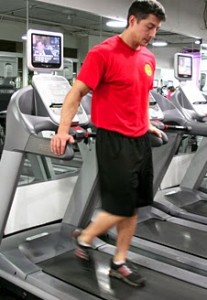
Did you know you’re wasting your time if you hold onto the rails when “walking” backwards on a treadmill?
Watch someone doing this. How does their posture look?
I’m a former certified personal trainer, and from time at the gym I saw a person walking backwards on a treadmill and holding on.
You may think, “Gee, isn’t that the smart thing to do? Otherwise you’ll fall, right?”
I walk backwards on a treadmill all the time and I never hold onto the rails.
To do so is akin to lying back-down on a floor, grabbing a rope in front of you that’s tethered to a base, holding it at your chest, pulling yourself up into a sitting position, and then saying you just did a sit-up.
You won’t fall if you train correctly and believe a little more in yourself.
Retro walking on a treadmill while holding on is an exercise (no pun intended) in futility.
People I see walking backwards on a treadmill are almost always in their 20s and 30s. The vast majority are women.
Can you retro walk across your living room?
If yes, then you can walk backwards on a treadmill without holding on.
Why do you retro walk on a treadmill?
Is it because you heard that it can lessen pre-existing knee pain? Did you read somewhere that walking backwards stimulates muscles that going forward misses?
Whatever your reason, holding on will defeat the purpose and encourage bad posture.
If you want to improve your posture, retro walking on a treadmill sans holding on will do wonders at improving your spinal posture!
You will be forced into perfect posture by keeping your hands off the rails. This beats walking around with a book on your head any day.
The minute you place your hands on the rails, there’s no longer a need to keep the spine erect and shoulders square.
Want to improve your balance? Let go. You can’t improve balance (be it in martial arts, dance, yoga or whatever) by holding onto something, though some people initially must hold on to a support.
But even then, in the case of martial arts, ice skating, etc., the goal is to perform the activity without clinging to anything.
This should be the case with retro walking on a treadmill.
To get the full benefits, to engage your entire body, to really tap into the core and strengthen these muscles, and to improve coordination and balance, you must walk with your hands free.
Set the speed at 1 mph and give it a try.
Grasping the rails while your feet get moved on a 4 mph tread is worthless.
Retro walking with your hands free will strengthen the ankles, too. Using the rails will block this effect.
- Start slowly.
- As you acclimate, increase speed a little.
- Keep your eyes fixed on a point that stabilizes you.
- If you must keep your eyes on your feet at first, then do so. Gradually move them out more as you acclimate.
“Some treadmill companies manufacture a rail that can be placed over the treadmill for stabilization while walking backwards,” notes Dr. Charles J. Pelitera, assistant professor of kinesiology and coordinator of the Health/Wellness Program at Canisius College, NY.
He adds that “there is more benefit to not holding onto a rail while walking backwards, but there is a proprioceptive learning curve in regards to being confident enough to not hold on.”
The learning curve is psychological. A former client of mine was a 65-year-old, 220-pound woman with arthritis in her knees.
I had her retro walking on the first session — without holding on. She had a bear of a personality, so it’s not surprising she showed no fear and adapted quickly.
“Once mastered, retro-walking can be a great method of cross training,” says Dr. Pelitera.
Retro walking on a treadmill produces a number of benefits, but only if you do not hold on.

 Dr. Pelitera
Dr. Pelitera









